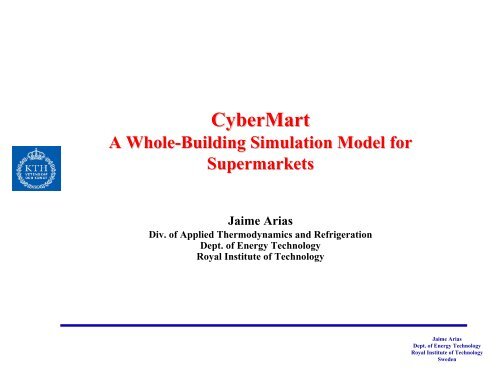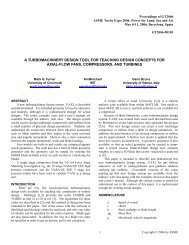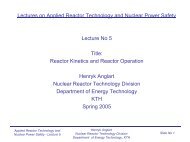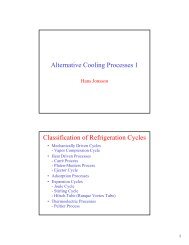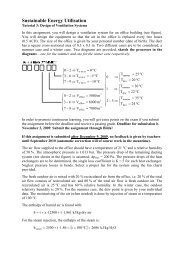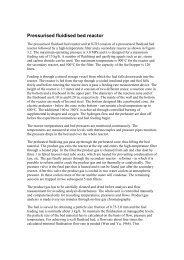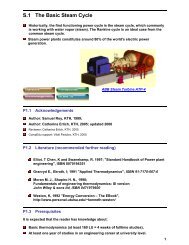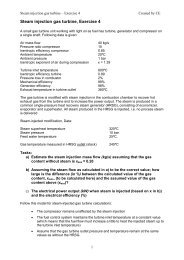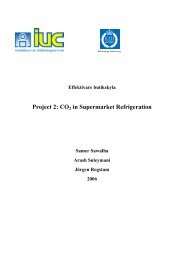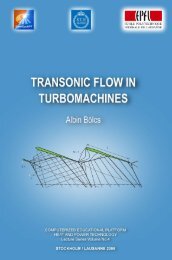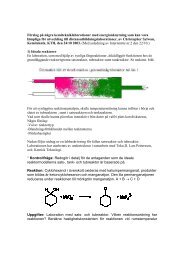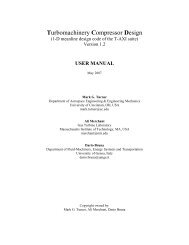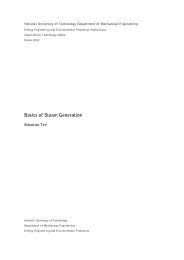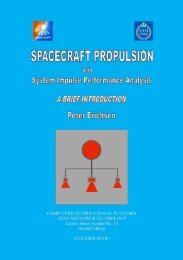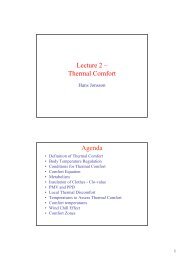CyberMart
CyberMart
CyberMart
- No tags were found...
Create successful ePaper yourself
Turn your PDF publications into a flip-book with our unique Google optimized e-Paper software.
<strong>CyberMart</strong>A Whole-Building Simulation Model forSupermarketsJaime AriasDiv. of Applied Thermodynamics and RefrigerationDept. of Energy TechnologyRoyal Institute of TechnologyJaime AriasDept. of Energy TechnologyRoyal Institute of TechnologySweden
Contents1.- Introduction.2.- <strong>CyberMart</strong>, Systems and Models.3.- <strong>CyberMart</strong>.4.- Evaluation of <strong>CyberMart</strong>.5.- Conclusions.Jaime AriasDept. of Energy TechnologyRoyal Institute of TechnologySweden
1.- Introduction.Energy-saving technologies as heat recovery, floatingcondensing temperature, energy efficient lighting, energyefficient display cases have been implemented in severalsupermarkets.The supermarket branch has more and less used the trialand error approach to implement and evaluate new ideasand concepts.A systems model is necessary to be implemented in order topredict and evaluate the introduction of new concepts andideas in supermarkets.Jaime AriasDept. of Energy TechnologyRoyal Institute of TechnologySweden
1.- Introduction.The main objective of the project was to create a user-friendlycomputer program for simulation of indoor climate in differentsupermarkets, where the influences from cabinets, lighting,people, heat recovery, air conditioning and outdoor climate aresimulated.Jaime AriasDept. of Energy TechnologyRoyal Institute of TechnologySweden
The Supermarket SystemSystem BoundariesElectricityDistrict heatingDistrict coolingRefrigerationSystemAmbient conditionsHVACSystemHeatCabinetSystemIndoor conditionst = 22C, HR = 65%Jaime AriasDept. of Energy TechnologyRoyal Institute of TechnologySweden
Main ProgramSystem designLCCTEWIOutdoorClimateBuildingHeatRec.IndoorClimateA.C.CabinetsColdRoomsDefrostPipes andpumpsBrineCompressorEvaporatorChillerCondenserExpansionValvePipes andpumpsDry CoolerFluidDry CoolerJaime AriasDept. of Energy TechnologyRoyal Institute of TechnologySweden
Building ModelHeat Balance room airHeat gains to room air – Heat losses from room air = 0Q con – H v * (T s – T r ) – H w * (T r – T o ) – H c * (T r – T s ) – Q g =0whereQ con = Q sol. + Q p. + Q eq. + Q l. - Q cabconH w : Specific loss from room air to outside W/KH V : Specific loss from room air to ventilation air W/KH c : Specific loss from room air to room surfaces W/KJaime AriasDept. of Energy TechnologyRoyal Institute of TechnologySweden
Heat Balance room surfacesHeat gains to room surfaces – Heat losses from room surfaces = 0Q rad + H c * (T r – T s ) – H ac * (T s – T ac ) = 0whereQ rad = Q sol. + Q p. + Q eq. + Q l. - Q cabradH ac : Specific loss from room surfaces to structure W/KH c : Specific loss from room air to room surfaces W/KJaime AriasDept. of Energy TechnologyRoyal Institute of TechnologySweden
Heat Balance building structureHeat gains to structure - Heat losses from structure = Accumulated heat instructureH ac *(T s – T ac ) – H out *(T ac – T o ) = C A *dT S /dtwhereC A : Total heat capacity of the room Wh/°KdT S : Variation of structure temperature °Cdt : time period hH ac : Specific loss from room surfaces to structure W/KH out : Specific loss structure to outside W/KJaime AriasDept. of Energy TechnologyRoyal Institute of TechnologySweden
The equivalent outdoor temperatureT e = T out + (I sol α sol + (T sky – T out ) *α r )/ α eWhere:T out : Outdoor temperatureT sky : Sky temperatureα sol : Absorptivity for solar radiationα r : Radiative heat transfer coefficientα e : Effective heat transfer coefficientα e = α r + α cJaime AriasDept. of Energy TechnologyRoyal Institute of TechnologySweden
HVAC ModelmfreshT1RHEXT2T3T4AC HR AHT5T6TsupmsupOutdoorX1X2X3 X4Re-circulationX5X6XsupSupermarketmrecirT7moutX7mretJaime AriasDept. of Energy TechnologyRoyal Institute of TechnologySweden
Air massflowOutdoor TemperatureAir Cooled CondenserUAcond.Discharge LineCompressorLiquid LineCompressor PowerSuction LineExpansiondeviceEvaporatorCabinetCold StorageEvaporatorUAevap.UAevap.Jaime AriasDept. of Energy TechnologyRoyal Institute of TechnologySweden
Completely Indirect SystemOutdoor TemperatureDry CoolerUAdrycoolerCoolant fluidPumpUAcond.Compressor PowerChillerUAevap.PumpSecondary refrigerantUAcabinetCabinetIndoor TemperatureJaime AriasDept. of Energy TechnologyRoyal Institute of TechnologySweden
QlightingQheatingwiresQinfiltrationQradiationQwallQ&Q&Q&Q&Q&Q&wallinfradlighfheatdef= 7.3%= 65.7%= 8.6%= 10.8%= 7.6%= 0%QfanQdefrostQloadJaime AriasDept. of Energy TechnologyRoyal Institute of TechnologySweden
QwallQheatingwiresQradiationQinfiltrationQwallQ&Q&Q&Q&Q&Q&wallinfradlighfheatdef= 9.2%= 16.4%= 46.6%= 0%= 16.5%= 11.3%QdefrostQfanQloadJaime AriasDept. of Energy TechnologyRoyal Institute of TechnologySweden
Life Cycle CostPresent value of single costSCpnSC[ 1+( i − p)] nPresent value of annually recurrent costRCpn==RCn1−⋅n[ ( ) ]−n1+i − p( i − p)Life Cycle CostLCC = Inv + LCC + LCC + LCC +TOTALENERGYOM &REnvironmentLCCothersJaime AriasDept. of Energy TechnologyRoyal Institute of TechnologySweden
3.- <strong>CyberMart</strong>Jaime AriasDept. of Energy TechnologyRoyal Institute of TechnologySweden
Jaime AriasDept. of Energy TechnologyRoyal Institute of TechnologySweden
Jaime AriasDept. of Energy TechnologyRoyal Institute of TechnologySweden
Jaime AriasDept. of Energy TechnologyRoyal Institute of TechnologySweden
Jaime AriasDept. of Energy TechnologyRoyal Institute of TechnologySweden
Jaime AriasDept. of Energy TechnologyRoyal Institute of TechnologySweden
Jaime AriasDept. of Energy TechnologyRoyal Institute of TechnologySweden
Jaime AriasDept. of Energy TechnologyRoyal Institute of TechnologySweden
Jaime AriasDept. of Energy TechnologyRoyal Institute of TechnologySweden
Jaime AriasDept. of Energy TechnologyRoyal Institute of TechnologySweden
Jaime AriasDept. of Energy TechnologyRoyal Institute of TechnologySweden
4.- Evaluation of <strong>CyberMart</strong>.The DSA method was used to consider the sensitivity of theprogram. 36 parameters were analysed. The total sensitivityanalysis of the program is 5.6%.Jaime AriasDept. of Energy TechnologyRoyal Institute of TechnologySweden
Energy Usage MWh / yearMeasurement <strong>CyberMart</strong>SalaElectricity 1179 1149District Heating 53 39HjoElectricity 610 586District Heating 80 49Jaime AriasDept. of Energy TechnologyRoyal Institute of TechnologySweden
LambohovSimulation from <strong>CyberMart</strong>No HR or FCHR and FCVentilation [MWh/year] 93 93Lightings [MWh/year] 112 112Equipments [MWh/year] 80 80Heating [MWh/year] 108 30Refrigeration System [MWh/year] 335 263Total Energy Usage [MWh/year] 728 578Energy Cost [US$/year] 72100 57200Jaime AriasDept. of Energy TechnologyRoyal Institute of TechnologySweden
Jaime AriasDept. of Energy TechnologyRoyal Institute of TechnologySweden
Jaime AriasDept. of Energy TechnologyRoyal Institute of TechnologySweden
Lambohov Total Energy Usage 2006Measurement <strong>CyberMart</strong>January 54193 47290 12,7%February 46811 42449 9,3%Mars 50733 47102 7,2%April 50317 47062 6,5%May 54180 50950 6,0%June 54761 52692 3,8%July 58830 57220 2,7%August 56983 55113 3,3%September 52538 51358 2,2%Total 2006 479348 451235 5,9%Jaime AriasDept. of Energy TechnologyRoyal Institute of TechnologySweden
LambohovTotal Electricity Usage 2006100Out.Temp Tot.El.Meas. Tot.El.Cyb. Tot.Comp.Meas. Tot.Comp.Cyb.80Temp[°C], Power[kW]6040200-2012 01 02 02 03 04 05 06 07 07 08 09 10 11Time[day]Jaime AriasDept. of Energy TechnologyRoyal Institute of TechnologySweden
5.- ConclusionsThere is a great potential for improvement of energysystems in supermarkets.The system approach and the interconnection between thedifferent subsystem implemented in the program predict andevaluate the introduction of new concepts and ideas insupermarkets.A particular energy efficient solution for each supermarketis possible to achieve only when there is a balance betweenLCC, TEWI and performanceJaime AriasDept. of Energy TechnologyRoyal Institute of TechnologySweden
5.- Conclusions.The implementation of new energy saving technologies insupermarkets requires an extensive analyse of energyperformances.This analysis should be done during a long period to evaluateand compare the real energy performance with the theoreticalvalues calculated.Jaime AriasDept. of Energy TechnologyRoyal Institute of TechnologySweden


